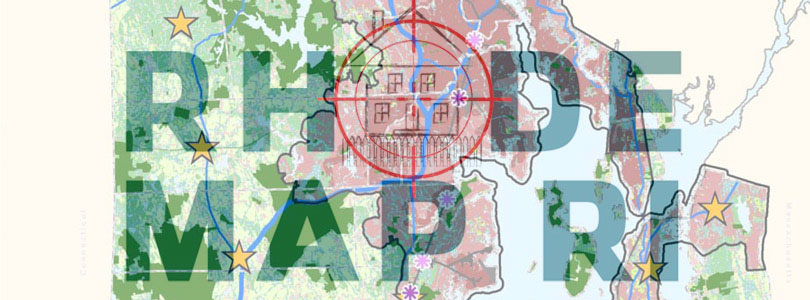RhodeMap Brings Eminent Domain One Step Closer
The U.S. Supreme Court set off a national firestorm, in June 2005, when its Kelo v. City of New London case ruled that government agencies could use eminent domain to take property from one person and give it to another for the “public good” of economic development. In Rhode Island, it became the subject of years of legislative debate (as followed by Carroll Andrew Morse, on Anchor Rising), culminating in the Rhode Island Home and Business Protection Act of 2008.
The act is arguably misnamed, merely stating that the government can do what people were afraid it would. With the RhodeMap RI plan currently on the cusp of becoming state policy, the meager protections will be even weaker.
The “legislative findings” of the act mainly affirm the precedent for eminent domain, the many agencies granted such power, and that “economic development purposes” are among the “more recently evolved powers of government.” The intention “to define, limit and restrict the use of eminent domain for economic development purposes” offers little comfort.
The law explicitly permits eminent domain for:
- “Providing for public ownership and use”
- “Providing for transportation infrastructure…”
- “Providing for public utilities…”
- “Eliminating … public harm and/or correcting conditions adversely affecting public health, safety, morals, or welfare, including, but not limited to, the elimination and prevention of blighted and substandard areas…”
- “Providing good and marketable title that is free and clear of liens and encumbrances when property is to be acquired or … conveyed for” the other reasons
“Blighted and substandard” areas are defined very loosely, even including “diversity of ownership of plots,” areas in which circumstances make “the sound growth of the community” somehow “unduly costly,” and “defective or inadequate street and lot layout.”
Moreover, blighted areas include “lands, buildings, or improvements” nearby. One property creating a “blight” can make all property in the area vulnerable to eminent domain. These options are so broad that they could cover almost anything — certainly a property that stands in the way of a RhodeMap RI growth center plan. More importantly, the statute does not say that these are the only reasons eminent domain may be used, and the next section makes clear that economic development confiscations are permitted, as well.
Although titled “Restricted use of eminent domain powers,” the section reads as instructions for going about it. Most prominently a government entity can use eminent domain if it has:
… a plan for the proposed development, which shall be approved by the governing body of the entity prior to the initiation of any eminent domain proceeding, which plan shall set forth the purposes of the development, the intended benefits to the community, the necessary infrastructure improvements, the presence and correction of any substandard conditions and/or environmental hazards, and the parcels which will be acquired in order to effectuate the plan.
That describes RhodeMap RI and, especially, the associated growth centers that the Division of Planning is putting together town by town. The only real protection, therefore, is that a city or town council must approve local takings and the General Assembly must approve state takings.
The RhodeMap plan and related language from the U.S. Dept. of Housing and Urban Development (HUD) frequently mention “regional” authorities. While the mechanics for creating such entities is murky, if the General Assembly has no control over a “regional” authority, then this section may not apply.
In general, though, there’s no reason to believe that approval from elected officials will offer much protection. Firstly, people are voted into office for a wide variety of reasons, and the political consequences for approving individual eminent domain takings may not be sufficiently scary to overcome whatever interests are pushing for it.
Secondly, other mechanisms might erode this protection. A pair of 2013 bills (S0696 and H5633) would have created local “community preservation committees” to instruct local councils on properties to buy for “sustainable development.” More recently, the RhodeMap planners have been open about mechanisms to pressure communities to approve their plans.
Thirdly, how a governing body approves eminent domain takings is not clear. In the extreme of laxity, one could say that a town council that approves a RhodeMap growth center plan has implicitly authorized eminent domain, if it is found that RhodeMap constitutes the “plan” required by the law.
In short, with every new growth center plan, and with every local and state approval of RhodeMap RI, the restrictions on the use of eminent domain erode. If Rhode Islanders want real protection against the government’s taking their property in order to give it to somebody who better fits The Plan, the people’s rights must be explicit: “This cannot be done.”



